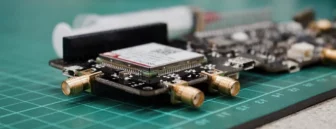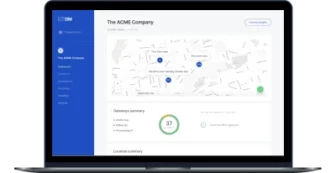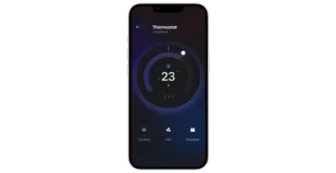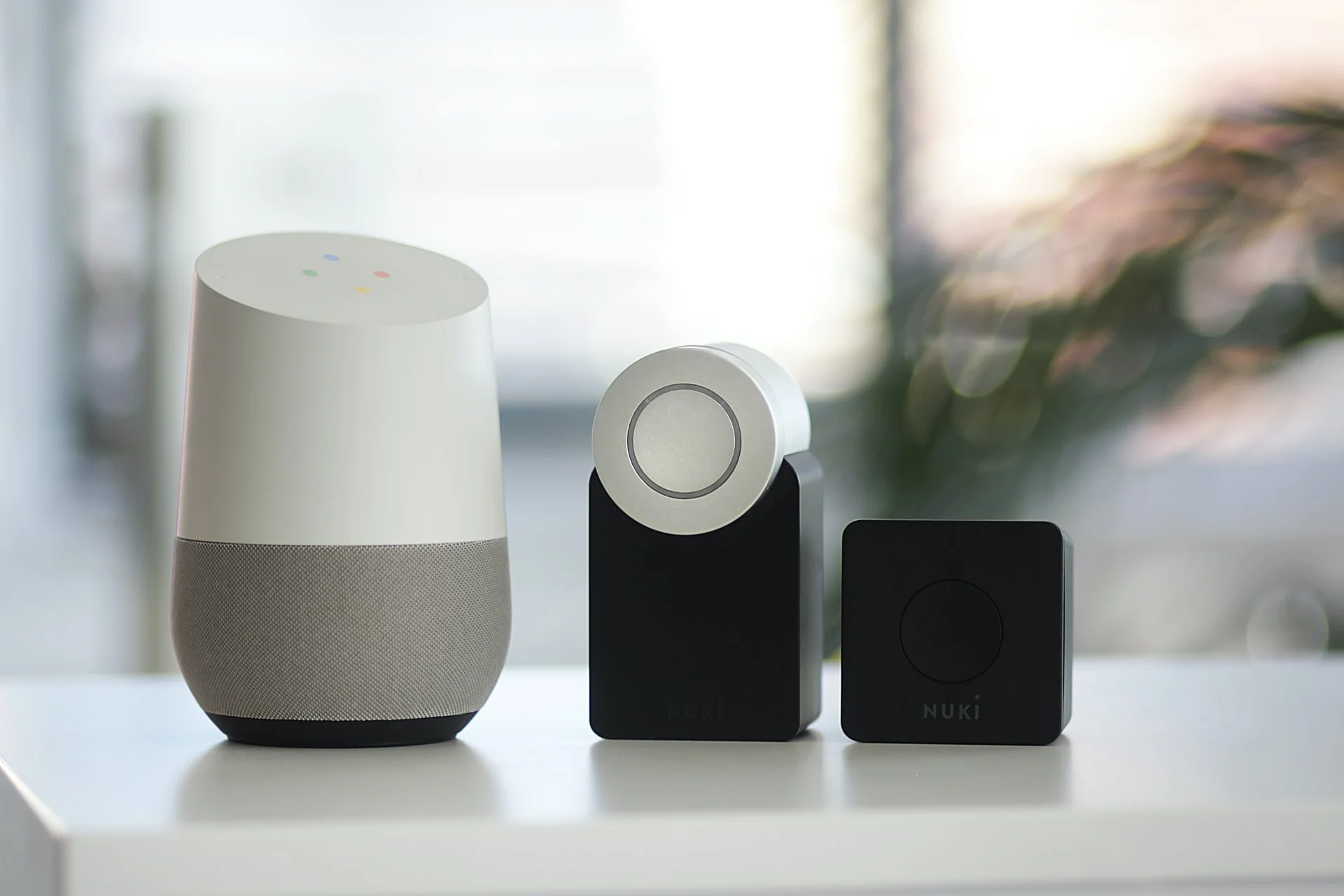
Smart Home Automation Development: From Architecture to Software
Smart home automation is among the top use cases of IoT technology according to McKinsey, as the B2C market for IoT devices has grown rapidly in recent years. This accelerated interest in smart home solutions is partially spurred by the fact that people have started spending more time at home due to COVID-19 and want to make their homes cozier and more convenient.
Smart home automation development: importance of reliable IoT technologies
Currently, B2C clients are cautious about choosing their custom home automation partner due to frequent instances when IoT companies have abruptly ceased operations, as happened with the IoT manufacturer Insteon. Executives didn’t manage to sell the company, and in April 2022, Insteon left the market without even warning its customers. This left lots of people with IoT devices that were no longer supported.
IoT technologies usually include hardware and software components. In this article, we focus on home automation app development for efficient IoT device management. Only with the right combination of IoT hardware and software can you deliver exceptional service to your customers. Developing secure and smoothly functioning IoT technologies can help you more easily find reliable investors and acquire new customers.
But when beginning smart home solution development, you may face lots of challenges. Let’s discuss how to solve at least some of them.
How to overcome common challenges of adopting smart home technologies
Despite a growing B2C IoT market, many people still aren’t ready to adopt home automation system design. In this section, we discuss common challenges that stop users from adopting IoT technologies and require additional effort and investment from IoT service providers.
High implementation costs. When it comes to IoT, it’s always about the cost. When we think of smart home solutions, we usually imagine a large futuristic house. Many people believe that smart homes are an idea of the future and that only the rich can afford smart home technologies. However, the IoT market has been developing for years, and most IoT devices for household use don’t cost a fortune. The key for the smart home developer is to create easy-to-navigate and smoothly functioning intelligent home systems to justify their cost to your customers. People are readily investing in high-quality IoT devices that can make their lives easier.
Unclear value. Installing IoT devices might seem like entertainment rather than a necessity. There are IoT devices that are used merely for entertainment, but there are also quite convenient devices that can ensure your home is secure while you’re away, for instance. Your task as an IoT service provider is to ensure you provide value to your clients. Thus, it’s critical during smart home automation programming to enrich your solution with a wide and useful set of functionality and constantly study your customers’ feedback.
Lack of interoperability. No matter how many IoT devices you own, if they don’t communicate with each other and you can’t manage them from a central hub, they won’t be useful. It’s essential to provide modern customers with a centralized IoT management platform that can serve as a hub for all connected home appliances and create the feeling of an integrated and full smart home system.
Security and privacy concerns. IoT devices and solutions can often be compromised if not properly secured. Users are cautious about entrusting their homes to IoT partners that fail to prove the security of their solutions. Later in this article, we discuss how to ensure the security of IoT software. Primarily, it’s about setting up a secure software development lifecycle (S-SDLC) during iOS or Android smart home app development for home automation. It’s also critical for IoT solutions to comply with international and local data protection acts and regulations, like the GDPR in Europe.
Different user groups may have different reasons for not adopting IoT technologies. Study your target audience and tackle their critical challenges.
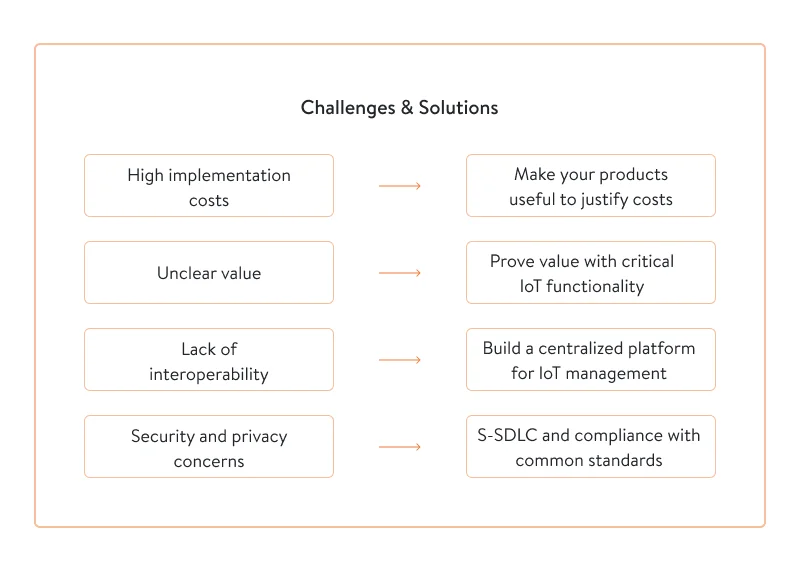
Having covered smart home adoption challenges, we can now discuss use cases and functionalities of smart home software solutions.
Smart home app development: use cases and functionalities
The functionalities you can include in your IoT software solution depend on the type and number of supported IoT devices. Whether you’re an IoT device manufacturer or an IoT software service provider, you’ll need to build software that can cover most of your end customers’ needs. You can build a smart home product that can become the house control system for a large set of IoT devices.
Security and safety
Security is often the main reason why customers decide on IoT devices. Keeping an eye on your house at a distance is one of the benefits IoT solutions offer. For instance, IoT company Netatmo provides users with smart surveillance cameras and doorbells. The Netatmo Smart Video Doorbell allows users to see their visitors and speak with them remotely.
Netatmo also allows customers to manage all of their security devices via a single mobile application as well as receive real-time notifications in case of any suspicious activities in or near the house. Remote home monitoring is worth including in any IoT software solution.
Automation of household chores
Another popular use case of IoT devices is automating household chores, which can save a lot of time. There are many home appliances and even whole smart home solution development products that can take care of household chores.
For instance, the June oven is a smart oven with multiple functions that can be managed remotely from a mobile app. Users can remotely preheat their meals or watch a live video of their food cooking. The oven has a camera with a food recognition engine, so the moment food is put in the June oven, it determines what’s cooking and offers the best mode to cook it. Plus, the app sends notifications when food is ready.
Another example is the Bosch Home Connect app, which allows customers to control all of their Bosch smart home appliances. In fact, other manufacturers including Siemens, Gaggenau, and NEFF have similar apps. The Bosch app is especially useful for managing an entire set of kitchen appliances to make the cooking and cleaning processes easier. The app is also a great assistant, as it offers a wide range of articles and recipes to simplify household chores.
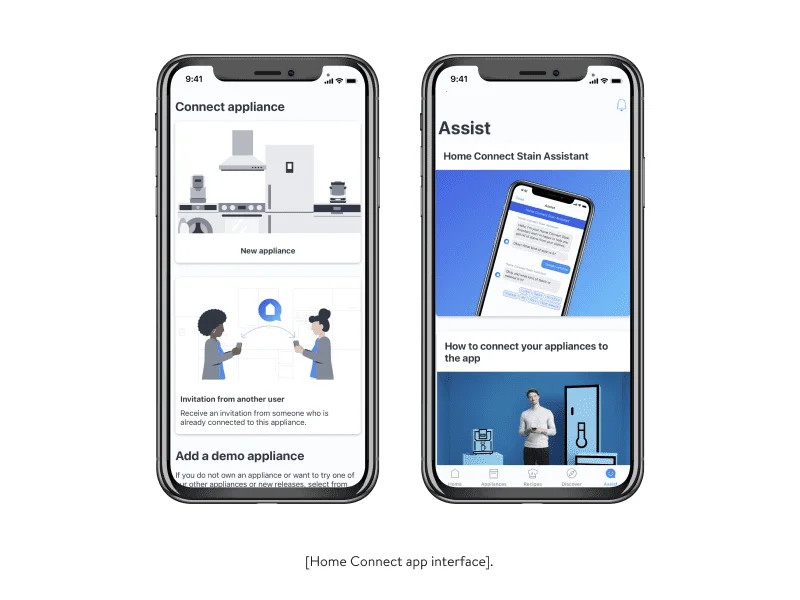
Climate control
Controlling temperature, humidity, and air quality at home are also considered essential home automation platform features. Companies such as Nest and Ecobee offer smart thermostats that allow for tailoring home temperature. Ecobee also has an eco+ functionality with which customers can preheat and precool their homes before coming, improving energy efficiency.
Ecobee devices don’t have their own software but rather connect to common solutions such as Amazon Alexa, Apple HomeKit, and Google Assistant to provide iOS and Android full smart home automation platform.
Relying on these home automation solutions will result in less flexibility for users, however, and may not allow users to access the full potential of your device. For example, users might not be able to view historical charts of home temperature over time.

Entertainment
Using IoT devices for entertainment is important for many customers, especially for busy families with children. Software solutions such as Roomie Remote help customers control their audio and video systems. Using Roomie Remote, users can browse audio, video, and other media on their Apple TV with gestures or voice. Apart from entertainment functionality, Roomie Remote helps users monitor other devices like thermostats, surveillance cameras, and lights.
In the next sections, we discuss how to build scalable, secure, and attractive home automation software.
How to build a smart home system
There are lots of IoT device manufacturers. And users often have a few devices from different manufacturers. They may find it inconvenient to use a separate mobile app or web platform for each device. It’s much easier when all IoT devices are connected, communicate with each other via a single communication protocol, and are managed through a centralized IoT platform.
In a previous article, we covered the main aspects of remote IoT management for large device networks. You can read that article if you’re considering providing your IoT services not only for B2C clients but for large enterprises.
Within this section, we discuss three aspects of developing a smart home management system:
- Setting up a cloud environment for IoT data collection and storage
- Ensuring IoT software security according to industry standards
- Enabling IoT data analytics and visualization
Cloud-based IoT data processing and storage
Ensuring proper IoT data aggregation, processing, and storage is a significant element in building IoT management systems. Since IoT data is unstructured and often generated in real time, it’s necessary to establish a suitable cloud environment. Multiple AWS services like AWS IoT Core and AWS IoT Device Management allow for connecting as many IoT devices to the cloud as necessary. You can also consider checking out our article on real-time data processing for even more insights into real-time data management.
The most suitable service for IoT data storage is an Amazon S3 bucket or a data lake. Data lakes can store vast amounts of unstructured data. In our detailed guide on data repositories, we discuss how a data lake differs from other data storage systems and cover its benefits for enterprises.
To give you an example of a successful IoT system launch in the cloud, we’ve chosen the electronics manufacturer Belkin, which has started producing a set of devices for smart home automation. As the number of smart home devices and clients grew, Belkin’s management realized the company’s on-premises IoT home automation architecture couldn’t handle the load, so they decided to switch to a cloud architecture. The results of this decision were impressive:
- The software development lifecycle (SDLC) was shortened by more than 40 percent, from 12 months to 6.5 months
- The company saved 30 to 40 percent on operating costs
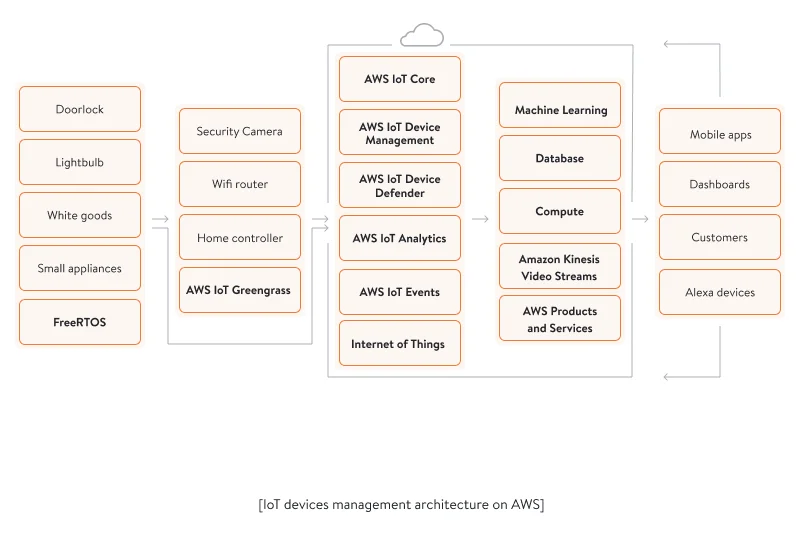
For RAKwireless, an IoT device manufacturer, we built a scalable IoT solution with the help of AWS IoT Core and AWS Lambda services. Thanks to our solution, RAKwireless managed to reduce the time spent on IoT network setup and maintenance and is now prepared to provide their services to a much larger number of enterprises.
Cloud computing can be the right choice for developing your IoT management platform if you expect your company to scale. As we’ve seen with Belkin, cloud solutions also reduce the duration of the SDLC and help you optimize your investments in IoT software development. In fact, it’s a growing tendency among IoT service providers to migrate their infrastructure to the cloud. So if you’re only entering the IoT market, it’s worth building a robust cloud infrastructure from the very beginning to avoid the future hassle of cloud migration.
Read also: Cloud migration checklist: 7 steps to successful app migration
How to make a home automation app as secure as possible
Throughout this article, we’ve emphasized that you should pay attention to developing the most secure smart home system possible. Nobody would be pleased to find out their surveillance camera was hacked and now anyone can enter their house unnoticed. To release secure IoT products, it’s important to adhere to security principles during all stages of the SDLC.
Plus, it can be beneficial to follow a specific set of industry standards, such as the Platform Security Architecture (PSA).
Under the PSA, there are four critical steps a smart home developer should follow to develop secure IoT software.
- Analyze. During this step, the software development team should come up with a list of security requirements with the help of threat modeling techniques and vulnerability detection.
- Architect. This step requires designing a security architecture that meets PSA requirements and complies with the PSA’s ten security goals.
- Implement. The next step is building software with a security architecture design and ensuring hardware security. It’s also critical to establish secure communication between IoT devices and software solutions.
- Certify. Acquiring PSA certification is ultimately associated with the security of IoT technologies. Securing your IoT network in accordance with PSA standards not only offers additional protection but serves as a selling point, proving to your clients that you care about the quality of your services.
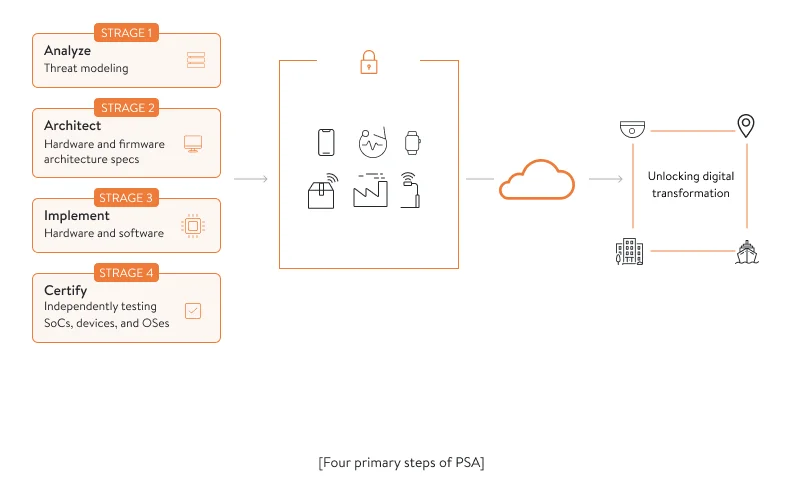
IoT solutions consist of hardware and software components, and security controls for them differ. In fact, there is no one-size-fits-all security approach for IoT systems, so it’s necessary to customize security controls to each hardware and software product.
Security controls for IoT hardware in smart home development
- Secure Boot. This is the process of verifying an IoT device’s firmware with the help of cryptographic hash algorithms (IoT firmware development). To ensure Secure Boot, the device is programmed with security keys and signatures.
- Root of Trust. A Secure Boot environment also requires Root of Trust, a set of identity and cryptographic keys built into IoT hardware. Root of Trust is usually considered the heart of the IoT device.
- Device authentication. Each device in the IoT network should go through an authentication procedure before it connects to the gateway to ensure it isn’t compromised and can be trusted.
- Encryption algorithms. To ensure a high level of IoT system security, you can use a combination of symmetric and asymmetric encryption algorithms. For instance, an asymmetric RSA algorithm and a symmetric Blowfish algorithm can be well implemented in IoT hardware due to low power consumption.
- Point-to-point encryption. It’s critical to encrypt data from the point of its capture by the IoT device until this data reaches its decryption point, such as an IoT gateway or the cloud environment.
Security controls for IoT software in smart home automation
- Routing security. Encrypting and hashing routing tables with data stored in the router as well as maintaining multipath data routing help to improve IoT data security and increase the fault tolerance of the IoT network.
- Securing user data. To avoid unauthorized system access and ensure the confidentiality of user data, you should establish authentication and identity verification mechanisms in your IoT software.
- Access control lists (ACLs). Another useful solution for securing IoT applications development is creating ACLs, which include policies and permission guidelines for who can access the IoT network. ACLs can either give access to the system or block it for internal and external system users.
- Firewalls. An additional security measure is establishing firewalls. This solution comes into play to block unauthorized access and logging attempts if authentication mechanisms and ACLs fail or are broken.
- Protective software programs. Antivirus and anti-spyware programs can be an additional security measure that can save the IoT system from potential malicious attacks.
The above list of security controls can be modified depending on the needs of each particular IoT project. And apart from all the security controls, you and your software development team should hold regular risk assessment and trust management sessions.
Risk assessment includes:
- detecting new hardware and software threats
- applying updates and patches
- upgrading and improving the IoT system
Trust management includes:
- validating trusted relations between software architecture components
- checking the security and privacy at each architectural level
- maintaining trust between IoT devices and users
Read also: Security best practices for web and mobile app development
IoT data analytics and visualization
Offering IoT data analytics and visualization services is optional, but it can give you a competitive advantage. However, such services may require more effort from your software development team, as common business intelligence and analytics tools may not support IoT data analytics due to the unstructured nature of IoT data.
In this case, we give preference to the AWS IoT Analytics service. It automates all stages of IoT data analysis. This service also connects with Amazon QuickSight, which enables data visualization with the help of machine learning algorithms. Unstructured IoT data comes in a raw format and may have gaps and false readings, and AWS IoT Analytics cleans the data before performing further analysis.
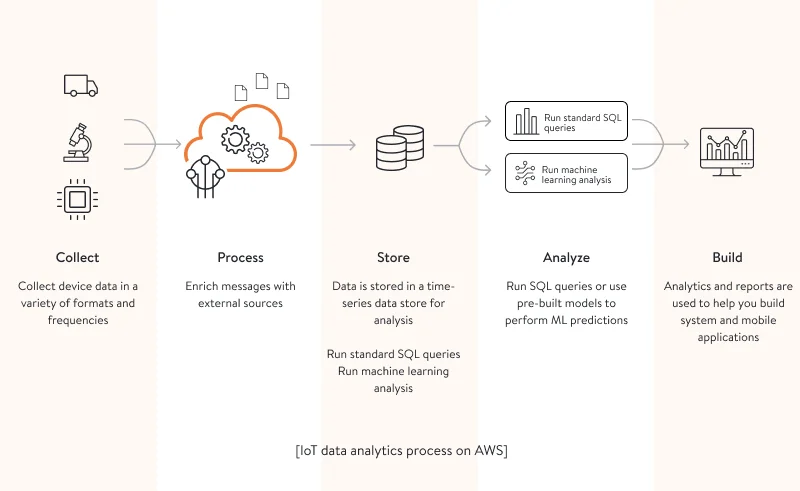
Key benefits of IoT data analytics services:
- IoT data isn’t merely collected but also generates insights and helps customers better see the tangible value of their IoT network.
- Enriching IoT data analysis with data from external sources like weather forecasts can help customers predict how to adjust their home temperature.
- IoT data analytics functionality can also allow customers to enhance their home’s efficiency by seeing patterns in household device productivity.
The last aspect of smart home software development is a unique UI/UX design that can either attract customers or repel them.
UI/UX design in home automation development
Users expect an advanced UI/UX design from smart home automation solutions. When downloading a brand-new digital banking app from their traditional bank, users may forgive certain design imperfections as long as the app performs critical banking services. But when it comes to smart home software, users expect something different and futuristic. At the same time, they expect the app to be convenient and useful.
A critical aspect that differentiates IoT home automation design from the design of other solutions is the direct connection between the digital and physical worlds. Designers need to find ways to make IoT software facilitate the use of physical IoT devices rather than cause confusion. Skeuomorphic design is no longer an option, but at least a small resemblance between the digital and physical IoT worlds should be preserved.
For instance, in the ConnectHome application we developed for our client, Yalantis designers displayed a thermostat as it looks in the physical world so users intuitively understand how to increase or decrease the temperature in their house. And naturally, they decided to indicate light control functionality with a bulb.
We’ve prepared a few tips that can help you ensure a proper UI/UX design for your IoT software:
- Include clear user onboarding. Setting up an IoT environment can be troublesome for non-technical users, so your task is to make their journey as clear and simple as possible. You can include engaging audio and visual elements in your smart home automation system design that will guide users through the onboarding process.
- Make your design inclusive. Assuming you want to provide your IoT products to as many people as possible, you need an inclusive design. For instance, it’s critical to make your home automation software understandable for people who are visually impaired or deaf.
- Add interactive chatbots for troubleshooting. To reduce the level of frustration users may have when facing issues with their smart home devices, you can provide an easy-to-find and interactive chatbot. Paying special attention to the design of troubleshooting functionality during home automation development is helpful for IoT software performance: a simple screen with instructions in plain text or just a button to request support may be insufficient.
- Choose futuristic colors, shapes, and fonts. IoT devices are associated with technologies of the future, so it would be great to make your smart home software look and feel futuristic, as we did with the ConnectHome app.

A combination of cloud computing technologies, proper security controls, and an attractive UI/UX design can help you develop robust IoT software. But make sure to focus on hardware components as well to make your customers’ experience of connecting the physical and digital worlds as seamless as possible. Make sure to entrust your IoT project to a reliable and experienced software partner with a product mindset. The Yalantis team would be glad to help you develop a dynamic smart home automation network that will allow your customers to make their homes their fortresses.
Rate this article
5/5.0
based on 1,117 reviews





